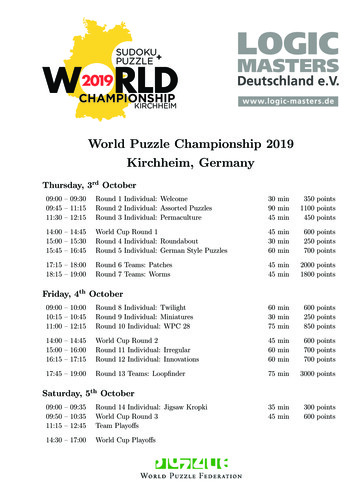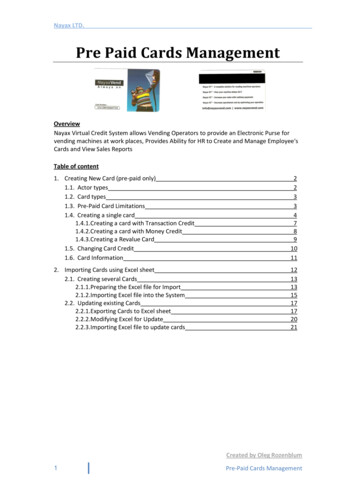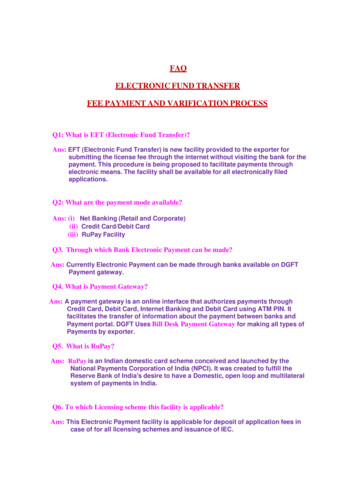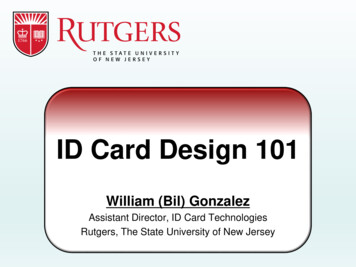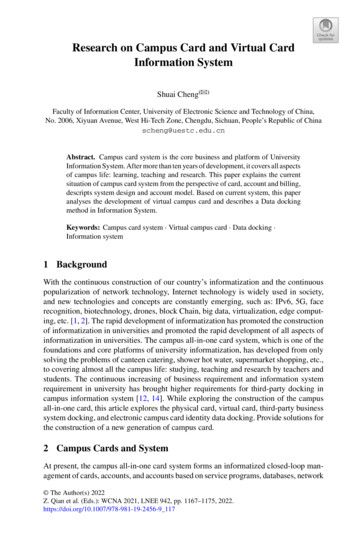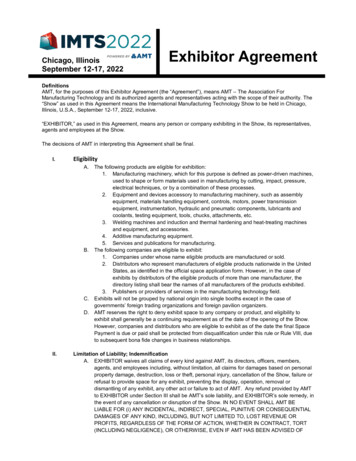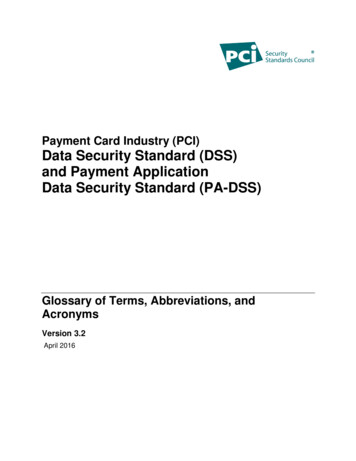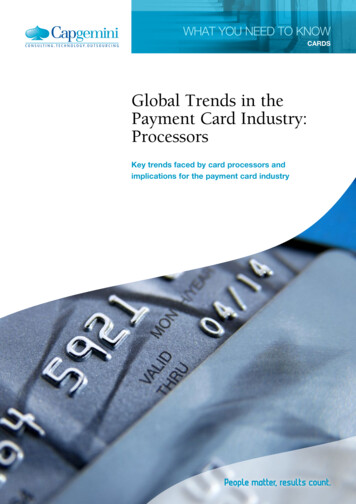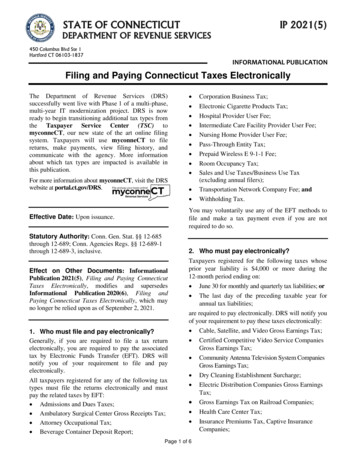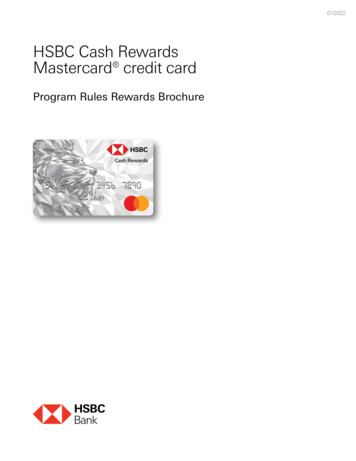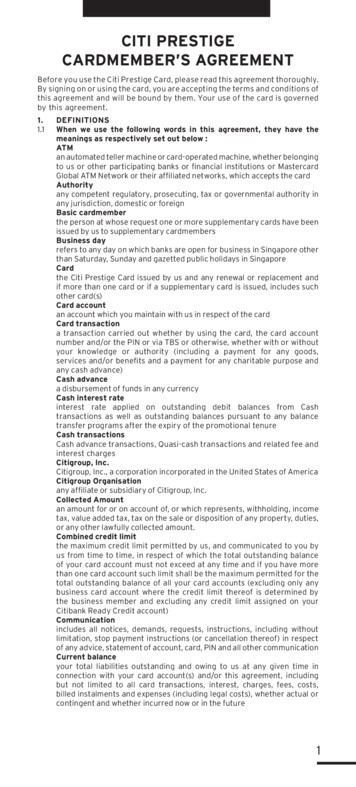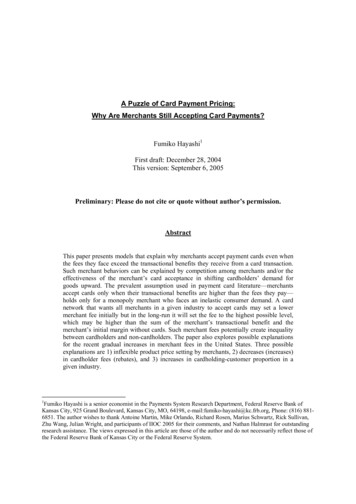
Transcription
A Puzzle of Card Payment Pricing:Why Are Merchants Still Accepting Card Payments?Fumiko Hayashi1First draft: December 28, 2004This version: September 6, 2005Preliminary: Please do not cite or quote without author’s permission.AbstractThis paper presents models that explain why merchants accept payment cards even whenthe fees they face exceed the transactional benefits they receive from a card transaction.Such merchant behaviors can be explained by competition among merchants and/or theeffectiveness of the merchant’s card acceptance in shifting cardholders’ demand forgoods upward. The prevalent assumption used in payment card literature—merchantsaccept cards only when their transactional benefits are higher than the fees they pay—holds only for a monopoly merchant who faces an inelastic consumer demand. A cardnetwork that wants all merchants in a given industry to accept cards may set a lowermerchant fee initially but in the long-run it will set the fee to the highest possible level,which may be higher than the sum of the merchant’s transactional benefit and themerchant’s initial margin without cards. Such merchant fees potentially create inequalitybetween cardholders and non-cardholders. The paper also explores possible explanationsfor the recent gradual increases in merchant fees in the United States. Three possibleexplanations are 1) inflexible product price setting by merchants, 2) decreases (increases)in cardholder fees (rebates), and 3) increases in cardholding-customer proportion in agiven industry.1Fumiko Hayashi is a senior economist in the Payments System Research Department, Federal Reserve Bank ofKansas City, 925 Grand Boulevard, Kansas City, MO, 64198, e-mail:fumiko-hayashi@kc.frb.org, Phone: (816) 8816851. The author wishes to thank Antoine Martin, Mike Orlando, Richard Rosen, Marius Schwartz, Rick Sullivan,Zhu Wang, Julian Wright, and participants of IIOC 2005 for their comments, and Nathan Halmrast for outstandingresearch assistance. The views expressed in this article are those of the author and do not necessarily reflect those ofthe Federal Reserve Bank of Kansas City or the Federal Reserve System.
1. IntroductionCredit and debit card payments are experiencing rapid growth. This rapid growth in cardpayments is attracting controversy and antitrust scrutiny in many countries. Recently, theEuropean Commission and the Reserve Bank of Australia have issued their decisions on pricingof card payments.2 Regulatory authorities in other countries, such as Mexico and the UnitedKingdom, are evaluating potential future regulations. At the center of those policymakers’attention are interchange fees, which are paid by the bank (called the acquirer) that processes thecard transaction for the merchant to the bank (called the issuer) that has issued the payment cardto the consumer. Interchange fees are typically set by the card network (or by its memberfinancial institutions collectively) and in many instances they are considered by regulators to betoo high.Chart 1 shows the credit card interchange rates in Australia and the European Union (EU),before and after the reductions of interchange rates were forced. In these regions, the regulator’sinvolvements on pricing of card payments lowered the credit card interchange rates significantly.The chart also includes the UK credit card interchange rates. In the United Kingdom, theantitrust authority has not decided whether it will regulate credit card interchange rates.3 But if itdoes, then some industry observers anticipate the rates will be cut to 0.7 percent or lower.4Current U.S. credit card interchange rates are also included in the chart. As seen in the chart, theU.S. interchange rates are even higher than the rates in the three regions before the interchangerates were lowered.2While the Reserve Bank of Australia has regulated the credit card interchange rates, the European Commission hasissued its decision to exempt Visa’s interchange fees under European competition laws. Visa has voluntarily reducedits interchange rates for cross-border transactions within certain European Union countries.3According to The Herald, November 11, 2004, a spokesman of the UK antitrust authority said “we would hope toissue a decision by the summer of next year.”4Industry observers expect the interchange rates in the United Kingdom to be between 0.35 to 0.7 percent. See, forexample, The Times, May 17, 2004 and November 11, 2004, and Financial Times, November 11, 2004.2
Chart 1: Credit Card Interchange Rates in Selected Current0.40%0.20%0.00%AustraliaEUUKU.S.Sources: Reserve Bank of Australia, Visa Europe, MasterCard International, and American BankerNotes: “Before” before the rate was forced to be lowered; “After” after the rate was lowered; “Current” as of November, 2004. In Australia, the regulation is effective for both Visa and MasterCard. The ‘before’and ‘after’ rates are the average of Visa and MasterCard rates. In the EU, the European Commission made itsdecision on the Visa rate for cross-border transactions only. The ‘before’ rate is not publicly available, but therate was estimated at about 1 percent according to the report “Credit Card Services” by the UK Monopoliesand Mergers Commission and others. In the United Kingdom, the antitrust authority has not made a finaldecision on the credit card interchange rates as of November 2004. Therefore, the ‘after’ rate is anexpectation by industry observers. They predict the regulated interchange rate will be between 0.35 to 0.7percent. (See footnote 4.) The U.S. rate is the average of Visa and MasterCard rates.Chart 2: Debit Card Interchange Fees for a 50 Transaction in Selected Countries 0.80 0.60Visa/MC offline 0.40Visa/MC online 0.20Domestic online 0.00- 0.20AustraliaEUUKU.S.Sources: Reserve Bank of Australia, Visa Europe, MasterCard International, and ATM & Debit NewsNotes: In Australia, there are no Visa/MasterCard online debit products. The domestic debit network’sinterchange fees are paid by issuers to acquirers. For the EU, only cross-border debit products are listed. Inthe United Kingdom, the domestic debit network and MasterCard agreed in 2002 that the domestic productswill be migrated into Maestro, the MasterCard online debit product by 2007. The rates shown were the 1998rates. In the United States, there exist more than ten domestic online debit networks. The rate shown asdomestic debit network is the weighted average of the top three domestic online debit interchange fees. Toconvert the currencies, the average exchange rates for the first three quarters of 2004 are used.3
Chart 2 shows the debit card interchange fees in selected countries. Interchange fees foroffline debit are higher than those for online debit.5 In Australia, the online debit interchangefees go in the opposite direction—paid by the issuer to the acquirer. Although the chart does notinclude them, many countries have domestic debit schemes with zero interchange fees.6 Similarto credit card interchange fees, debit card interchange fees in the United States are among thehighest in the world.In the United States, interchange fees for both credit and debit card transactions areamong the highest in the world. Moreover, they have been increasing very rapidly for the pastseveral years. Chart 3 shows the various interchange fees for a 50 transaction at a retail store inthe United States. Interchange fees for credit and online debit transactions have been increasing.Although the offline debit interchange rates were reduced after the settlement of a lawsuit by agroup of merchants against the two offline debit networks in August 2003, they have increasedsince 2004.Chart 3: Interchange Fees for a 50 Transaction at Non-Supermarket: 1999-2004 1.00MasterCard (credit) 0.80Visa (credit)MasterCard (offline) 0.60Visa (offline)Star (online) 0.40NYCE (online)Pulse (online) 0.20Interlink (online) 0.0019992000
U.S. interchange rates are even higher than the rates in the three regions before the interchange rates were lowered. 2While the Reserve Bank of Australia has regulated the credit card interchange rates, the European Commission has issued its decision to exempt Visa's interchange fees under European competition laws. Visa has voluntarily reduced
